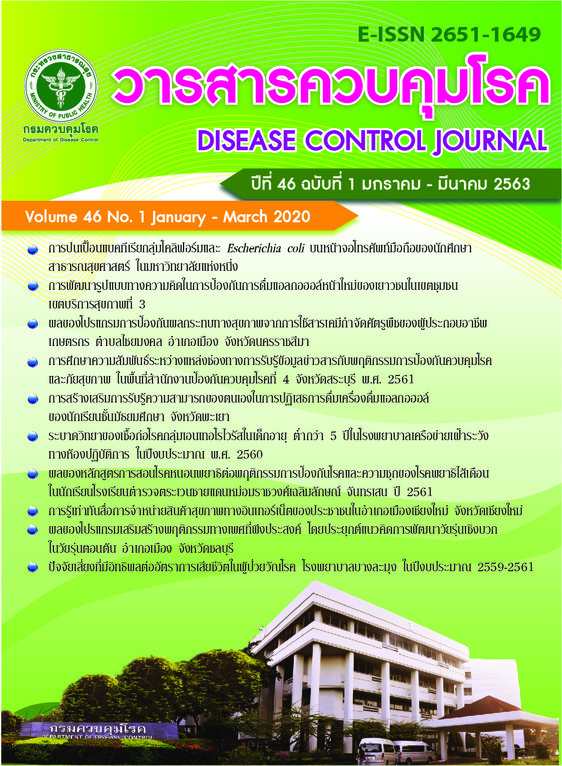Structural equation model for prevention of newcomer alcohol consumption among teenagers in a community under Public Health Region 3
DOI:
https://doi.org/10.14456/dcj.2020.2Keywords:
structural equation model, alcohol consumption prevention, teenagersAbstract
The purpose of this study was to develop a structural equation model for the prevention of newcomer alcohol consumption in a community. The study design was a cross-sectional analytical study. Population were teenagers aged between 15-24 years. The samples were 400 students selected by multi-stage sampling. The questionnaire was divided into 5 parts; first: demographic data; second: component of individual behavior such as knowledge, perceived severity, perceived benefit, perceived barrier and self-efficacy; third: component of interactive behavior such as family support, peer influences and reinforcement, and general perception and awareness; fourth: component of socio-environmental behavioral factors such as social support, laws and regulations, and public policies; and the last: component of behavior for the prevention of alcohol consumption. Research findings were as follows: the structural equation model with all latent variables could explain alcohol consumption prevention by 20 percent (R2 = 0.20). Furthermore, component of socio-environmental behavioral factors could explain variation in the component of individual behavior and component of interactive behavior by 74 percent (R2 = 0.74), and component of interactive behavior could predict potential influences from component of individual behavior by 65 percent (R2 = 0.65). Policymakers should consider applying the components of structural equation model in order to help prevent newcomer alcohol consumption in communities under the Public Health Region 3 and other areas with similar circumstances.
Downloads
References
World Health Organization. Global status report on alcohol and health 2018. Geneva: World Health Organization; 2018.
World Health Organization. World Health Statistics. Ganeva: World Health Organization; 2011.
World Health Organization. Global status report on alcohol 2004. Ganeva: World Health Organization; 2004.
World Health Organization. Global status report on alcohol and health 2014. Ganeva: World Health Organization; 2014.
Thammarangsri T. The situation of alcohol consumption and the impact in Thailand Years 2013. Bangkok: Graphico Systems; 2013. (in Thai)
Chaiyasong S, Phakdeesethakul K, Thammarangsri T. Provincial alcohol report 2011. Nonthaburi: Center for Alcohol Studies, International Health Policy Program Thailand; 2013. (in Thai)
Department of Diseases Control. Compulsory indicators related to official duty for staff under the Department of Disease Control fiscal year 2016 [Internet]. 2016 [cited 2016 Jan 6]. Available from: http://www.opdcddc.org/th/public-service-agreement/institution/list.php?year=2016 (in Thai)
International Health Policy Program, Ministry of Public Health. Thailand’s disease burden at individual health zone and regional levels, 2011. Nonthaburi: International Health Policy Program; 2015. (in Thai)
Sornpaisarn B, Kaewmungkun J, Watthanaporn K. Thailand’s 2006 annual report on alcohol abuse situations. Nonthaburi: Center for Alcohol Studies; 2010. (in Thai)
National Statistical Office. Smoking and drinking habits of Thai populations, 2014, National Statistical Office of Thailand. Bangkok: National Statistical Office; 2014. (in Thai)
Cohen. J. Statistical power analysis for the behavioral sciences. 2nd ed. New York: Lawrence Erlbaum Associates; 1988.
Hair JF, Black WC, Babin BJ, Anderson RE. Multivariate data analysis. 7th ed. New Jersey: Prentice Hall, Pearson Higher Education; 2010.
Kerlinger FN. Foundations of behavioral research. 2nd ed. New York: Holt, Rinehart and Winston; 1973.
Bollen KA. Structural equations with latent variables. New York: John Wiley & Sons; 1989.
Good CV, Winifred R. Model. Dictionary of education. New York: McGraw-Hill; 1973.
Glan K, Babara K, Viswanath RK. Health and behavior: the interplay of biological behavioral and societal influences. Washington, D.C.: National Academy Press; 2008.
Koning IM, Maric M, MacKinnon D, Vollebergh WA. Effects of a combined parent–student alcohol prevention program on intermediate factors and adolescents’ drinking behavior: a sequential mediation model. J Consult Clin Psychol 2015;83:719-27.
Boyle JR, Boekeloo BO. The association between parent communication and college freshmen’s alcohol use. J Drug Educ 2009;39:113-31.
Kumpfer KL. Family-based interventions for the prevention of substance abuse and other impulse control disorders in girls. ISRN Addict 2014;2014:1-23.
Brutovská M, Orosova O, Kalina O, Šebeňa R. Descriptive normative beliefs and the self-regulation in alcohol use among Slovak university students. J Public Health 2015;37:618-24.
Schuckit MA, Smith TL, Kalmijn J, Trim RS, Cesario E, Saunders G, et al. Comparison across two generations of prospective models of how the low level of response to alcohol affects alcohol outcomes. J Stud Alcohol Drugs 2012;73:195-204.
Downloads
Published
How to Cite
Issue
Section
License
Articles published in the Disease Control Journal are considered as academic work, research or analysis of the personal opinion of the authors, not the opinion of the Thailand Department of Disease Control or editorial team. The authors must be responsible for their articles.






